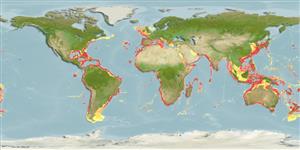Classification / Names
Common names from other countries
Main reference
Size / Weight / Age
Max length : 137 cm TL male/unsexed; (Ref. 247); 140.0 cm TL (female); common length : 100.0 cm TL male/unsexed; (Ref. 26999)
Length at first maturity
Lm 87.5, range 75 - 98 cm
Environment
Marine; bathydemersal; depth range 0 - 1000 m (Ref. 41394), usually 180 - 450 m (Ref. 45445)
Climate / Range
Deep-water, preferred 25°C (Ref. 107945); 58°N - 58°S, 98°W - 173°W
Distribution
Circumglobal in tropical and temperate seas, excluding the northeast Pacific (Ref. 13573). Western Atlantic: North Carolina, USA and northern Gulf of Mexico to Cuba, then from Venezuela to Argentina (Ref. 6871). Eastern Atlantic: Morocco to Namibia, including the Mediterranean Sea. Indian Ocean: southwestern India, Aldabra Island, southern Mozambique, and South Africa. Western Pacific: Japan to China, Indonesia, Australia and New Zealand. Southeast Pacific: off northern Chile.
Countries | FAO areas | Ecosystems | Occurrences | Introductions
Short description
Dorsal
spines
(total): 0;
Dorsal
soft rays
(total): 0;
Anal
spines: 0;
Anal
soft rays: 0;
Vertebrae: 125 - 161. A narrow-headed, big-eyed small seven-gilled shark (Ref. 247). Body fusiform and slender; dorsal fin small, originating over inner margins of pelvic fins; anal fin small (Ref. 6871). Teeth wide, low and comb-shaped (Ref. 6871). Brownish grey above, paler below, sometimes with indistinct dark blotches on body; juveniles with dark-tipped dorsal and caudal fins, adults with light fin margins (Ref. 5578, 6574, 6871). Live specimens with fluorescent green eyes (Ref. 6871).
IUCN Red List Status (Ref. 115185)
Threat to humans
Poisonous to eat (Ref. 4690)
Human uses
Fisheries: minor commercial
More information
ReferencesAquacultureAquaculture profileStrainsGeneticsAllele frequenciesHeritabilityDiseasesProcessingMass conversion
Tools
Special reports
Download XML
Internet sources
Estimates of some properties based on models
Phylogenetic diversity index
PD50 = 1.0781 many relatives (e.g. carps) 0.5 - 2.0 few relatives (e.g. lungfishes)
Trophic Level
4.2 ±0.4 se; Based on diet studies.
Resilience
Very Low, minimum population doubling time more than 14 years (Fec=9)
Vulnerability
High to very high vulnerability (73 of 100)
Price category
